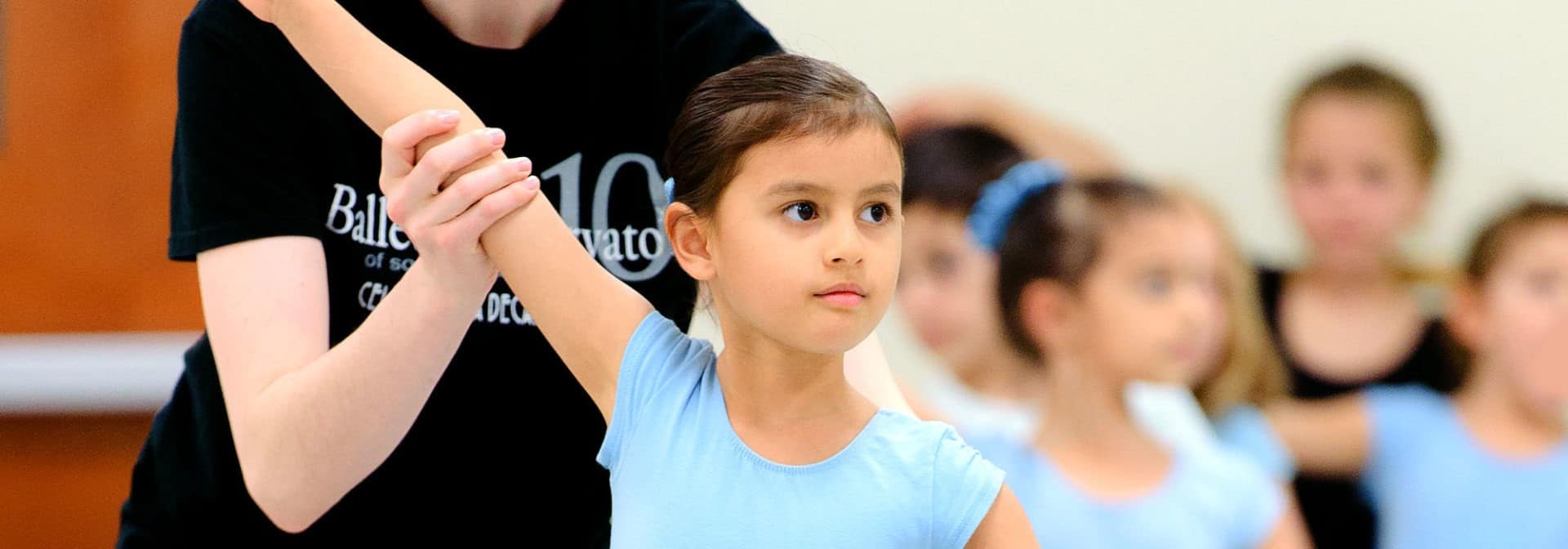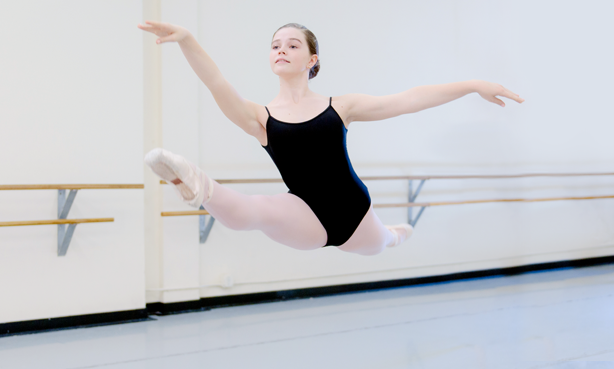
Frequently Asked Questions
What is Ballet?
Ballet is an art form created by the movement of the human body. Ballet is theatrical and meant to be performed on a stage before an audience, utilizing choreography, costumes, scenic design, music (either live or recorded), and lighting. A ballet performance can tell a story or express a thought or emotion. Ballet performances can be magical, exciting, provoking, and disturbing.
Ballet was originated in the Italian Renaissance courts of the 15th century and later developed into a concert dance form in France and Russia. It has since become a widespread, highly technical form of dance with its own vocabulary based on French terminology.
Becoming a ballet dancer requires years of training. The Ballet Conservatory is here to work with both the students who wish to dance as a fun after-school recreational activity, as well as to train committed students who aspire to become professional dancers.
What style of ballet is taught at The Ballet Conservatory of South Texas?
The Conservatory’s curriculum is based on the traditional Vaganova method with strong influences from methods of the Central Pennsylvania Youth Ballet (CPYB).
Our syllabus yields a solid classical ballet technique, which is the best base a dancer can achieve. CPYB has developed a curriculum that is focused on building technical strength, stamina and flexibility, as well as nurturing artistic development. The Ballet Conservatory of South Texas closely follows the CPYB curriculum.
LEVEL PLACEMENT QUESTIONS
Are dancers placed by their age or ability?
Our youngest students are grouped based on age because it has been scientifically proven that during specific age ranges, certain abilities, both mentally and physically either have or have not been developed yet.
For CREATIVE MOVEMENT, PRE-BALLET, and PRIMARY BALLET, we have a base curriculum to teach and guide our students according to the abilities of the whole class. We will never hold a child back simply because of age. However, age does not play a part in the process of being able to move to the next level of ballet. The ability of both the body and the mind is very important when graduating to the next level.
In the INTERMEDIATE and ADVANCED levels, the developmental speed of every person is different, and we base these levels solely on ability. We split levels up this way to protect our students from injury.
If you have a concern, you are always welcome to speak with your child’s instructor(s), who will help you and your child understand their level placement and what they may need to work on to advance to the next class level.
Why is my child repeating a level?
Being asked to repeat a level can be frustrating, but it is always in the best interest of the dancer. It is common for students who have repeated a level to become discouraged. This does not mean the student is not talented or gifted. The decision to not promote a dancer is based on what the instructor feels the student still needs to achieve. Working at a lower level helps the student make steady progress and sometimes these students become better in the long run.
Here are some valuable points to remember in your child’s ballet practice:
- The instructor is acting in your child’s best interest. Your child’s instructor wants your child to be successful, to progress steadily, and to become the best they can be.
- Strength and repetition are crucial to developing a strong technique – it takes time to become an advanced dancer. Perfecting ballet technique requires constant practice.
- There is always something a student can learn in ballet, even at the lowest level. The strongest dancers are frequently those who can absorb information and apply it in their practice. In the end, if you are concerned about your dancer’s class placement, please reach out to your child’s instructor.
When will my child be allowed to dance in pointe shoes?
Practicing in pointe shoes is reserved for students who have developed both their bodies and their minds. Each student takes their own time to develop the strength and coordination required to safely wear and practice in pointe shoes.
We cannot rush children into pointe shoes simply because of their age. Injuries occur most in students whose muscles, bone structure, and minds have not matured or strengthened enough to handle the grueling pains of pointe shoes. Not only does a child’s understanding of ballet terminology and execution of the steps need to be very finely tuned and consistent, but their muscles and bones need to have developed correctly as well.
For a young dancer to progress into pointe work, they must be in ballet class more than five or six hours a week in our pre-professional tract. Recreational students will not train in pointe shoes. The execution of ballet steps needs to become second nature so that when a student puts their pointe shoes on, the shoes enhance instead of hinder their movements.
By being able to observe a student’s body several hours each day, an instructor builds an understanding of how the student is developing, can guide the student through weaknesses, and help the student strengthen both her body and her mind. It is estimated that by the age of twelve, a student’s body may be mature enough to handle the stresses that practicing in pointe shoes places on muscles and bones, however, this is merely an estimate, and it is up to the instructor’s determination when an individual dancer may be able to safely attempt pointe work.
BALLET CONSERVATORY POLICIES AND PROCEDURES
What is the dress code and why is it required?
Yes, we do have a dress code, and it can differ from level to level. For more information about uniforms, please visit MOVIN’ EASY, our uniform retailer, for specific dress requirements for each of our programs.
Classical ballet training demands correct body alignment and placement, from the earliest stages. The only way an instructor can see this alignment is with the student attired in form-fitting clothing, including tights and leotards (or close-fitting t-shirt and leggings for boys).
Hair is worn up in a bun and off the face and neck, not only so the steps can be executed properly (i.e. head can move freely without hair flying in the face), but also so the instructor can see the alignment of the head and neck, which is also important.
We maintain our dress code for the benefit of our students. By following the dress code, a student will most likely become more familiar with her body and the way it moves. Hair that is improperly secured can become a nuisance and a distraction to the student during class.
If your child has any special needs, please inform the staff so that our teachers will be prepared to make necessary accommodations.
Will there be a recital?
At the end of each Spring Semester (late May or early June), the Conservatory produces an annual Academy Showcase, and all students from Creative Movement I to Ballet VI are invited to perform on a stage. Our performances are held in a local theater or auditorium with plenty of seating for parents and extended family and friends.
The Conservatory also offers several performance opportunities for our pre-professional company dancers throughout the performance season.
Parents are also invited into the studio to observe their child’s class twice each year during Parent Observation Week, which is typically scheduled near the end of the Fall and Spring semesters. We encourage every parent to take these opportunities to see their child at work in the studio during Parent Observation Week.

